Running your refrigerator on solar power is quite feasible since fridges consume a relatively low amount of energy. However, it’s important to note that relying solely on solar panels won’t be sufficient to make this project a reality.
To run a refrigerator on solar power, you would need a solar energy system that consists of:
- Solar panels: To produce the amount of energy necessary to run your refrigerator.
- A battery bank: To store all the energy produced by the solar panels and make it available to the refrigerator.
- A solar charge controller: To maximize power production and to protect the solar panels and the battery.
- An inverter: To convert low voltage DC power from the battery bank into a higher voltage AC power that the refrigerator can use.
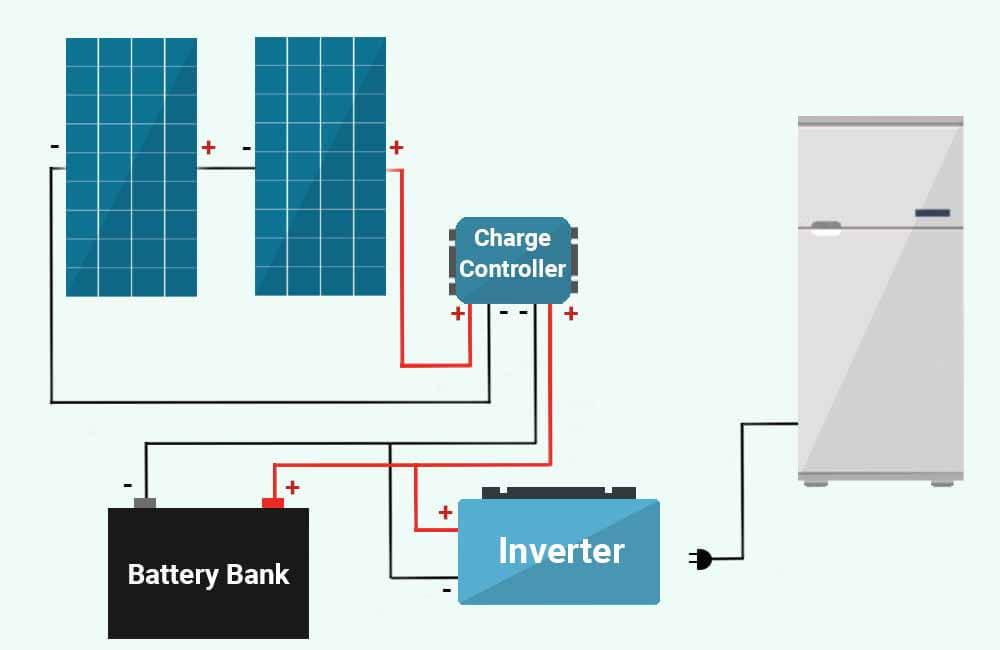
In this article, I’ll discuss in detail the amount of solar power that you would need to run your refrigerator, which will mainly depend on the energy consumption of your fridge and the amount of sunlight that’ll be available to your solar panels.
Once we’ve covered that, I’ll show you how to size each of the other components that I’ve mentioned above. Let’s dive in.
I get commissions for purchases made through links in this post.
How many solar panels do I need to power a refrigerator?
On average, full-size refrigerators (16 – 22 Cu. ft.) consume between 1500Wh and 2000Wh (Watt-hours) of energy per day, equivalent to between 1.5kWh and 2kWh (kiloWatt-hours) of energy.
Therefore, to run a full-size refrigerator on solar power, you would need a solar array that produces around 1500-2000Wh of energy per day. A solar array that produces this much energy would be rated at 300 to 600 Watts of power. Smaller refrigerators will consume less energy, and will therefore require less solar power to run.
The exact amount of solar power that you need will mainly depend on the energy consumption of your refrigerator, and on the amount of sunlight that you receive in your location.
To accurately determine how many solar panels you need to power a fridge, you will mainly need 2 pieces of information:
- An estimate of your refrigerator’s daily energy consumption, measured in Watt-hours (Wh) or kiloWatt-hours (kWh).
- An estimate of the amount of sunlight your solar panels would receive each day, measured in Peak Sun Hours (kWh/m2).
Before I explain how you can determine these 2 variables, to provide some perspective, here’s a table that estimates the energy consumption of different refrigerators of different sizes, as well as the amount of solar power that would be required to run each of them:
| Model | Size (Cu. ft.) | Estimated Annual energy consumption (kilo-Watt-hours) | Estimated daily energy consumption (Watt-hours and kiloWatt-hours) | Estimated solar power needed (Watts) |
| Kenmore 99059
|
4.5 Cubic Feet | 237 kWh/year | 650 Wh/day (0.65 kWh/day) | 100 – 200 W |
|
|
12 Cubic Feet | 312 kWh/year | 850 Wh/day (0.85 kWh/day) | 150 – 300 W |
| Frigidaire FFHT1425VV | 13.9 Cubic Feet | 332 kWh/year | 900 Wh/day (0.9 kWh/day) | 150 – 300 W |
| 20.6 Cubic Feet | 653 kWh/year | 1800 Wh/day (1.8 kWh/day) | 300 – 500 W | |
| 27.4 Cubic Feet | 728 kWh/year | 2000 Wh/day (2 kWh/day) | 300 – 500 W |
Please keep in mind that the energy consumption estimates provided in the table are specific to the mentioned refrigerator models. The actual energy usage of a refrigerator will vary not only based on its size but also based on the efficiency of the specific model.
To size the equipment necessary to run your refrigerator on solar power as accurately as possible, it is better to first determine the actual energy consumption of the fridge.
How much energy (in Wh or kWh) does your refrigerator use?
In the U.S., most refrigerators come with an EnergyGuide label that estimates their Annual Energy Consumption (kWh/year), which can be used to estimate their daily energy consumption (kWh/day).
For example, the EnergyGuide label below is from a 20.6 Cu. Ft. refrigerator:
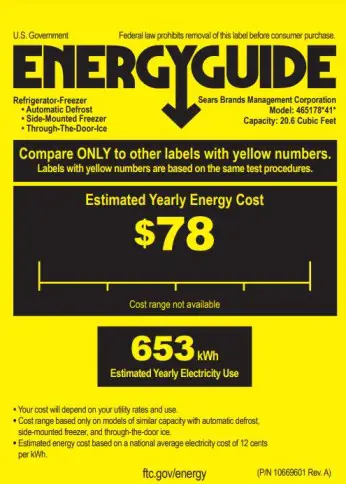
Estimated Annual Energy Consumption of 20.6 Cu. Ft. fridge (Source)
As shown in the image above, the label specifies an “Estimated Yearly Electricity” use of 653 kWh. To get an estimate of the daily energy consumption of this fridge, we simply divide its yearly energy consumption estimate by 365 (the number of days in a year):
Estimated Daily Energy Consumption (Wh) = 653 kWh ÷ 365 = 1.790 kWh/day = 1790 Wh/day
This is the easy and quick way, however, it is also possible to calculate your refrigerator’s energy consumption using the electrical specifications provided by the manufacturer.
How to calculate refrigerator electricity consumption?
To avoid confusion, here is a reminder of the difference between electrical power and electrical energy:
- Electrical Power: measured in Watts (W) or kiloWatts (kW), and represents the rate at which electricity is being consumed.
- Electrical Energy: measured in Watt-hours (Wh) or kiloWatt-hours (kWh), and represents the quantity of electricity consumed over a certain period of time.
The relationship between Power (Watts or kiloWatts) and Energy (Watt-hours or kiloWatt-hours) is expressed as such:
Energy Consumption (Wh) = Power Usage (Watts) x Usage Duration (hours)
For example:
Let’s say I have a 60 Watt light bulb that I leave on for 5 hours a day, the daily energy consumption of this 60W light bulb can be calculated as such:
Daily Energy Consumption (Wh) = Power Usage (Watts) x Daily Usage Duration (hours)
Daily Energy Consumption (Wh) = 60 Watts x 5 Hours
Daily Energy Consumption (Wh) = 300Wh (Watt-hours)
The energy consumption of a refrigerator can be calculated similarly.
Therefore, to estimate how much energy (Watt-hours) a refrigerator uses, we’ll need to determine:
- How much power does the fridge use (Watts)?
- How many hours does the fridge actually run for in a day (hours)?
How many watts does a refrigerator use?
As explained above, the power usage of a refrigerator represents the rate at which it consumes electricity, and while older refrigerators can use up to about 700 Watts of power, the newer and more energy-efficient ones only use about 150-300 Watts.
The power usage (Watts) of your refrigerator can be found on the manufacturer’s specification label or can be calculated using other electrical specifications, such as its Amperage (Amps) and Voltage (Volts).
For example, the image below is of a specifications sticker of a 29.3 Cu. ft. LG refrigerator:
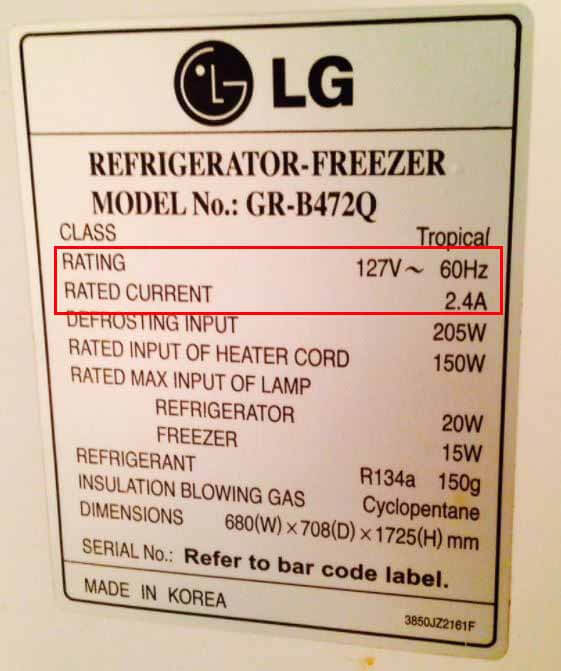 On the specification label, the wattage of the refrigerator is usually specified under Rated Input (Watts).
On the specification label, the wattage of the refrigerator is usually specified under Rated Input (Watts).
However, in some cases, such as this one, the manufacturer does not specify the rated power usage of the refrigerator in Watts and instead specifies its Rated Amperage (Current) in Amps (A) and its Rated Voltage in Volts (V).
In such a case, the Amperage and Voltage of the refrigerator can be used to calculate its Wattage:
Wattage (Watts) = Voltage (Volts) x Amperage (Amps)
Learn more about Amps, Volts, Watts, and the relationship between them here.
For example, in the specification sticker provided above, notice that the manufacturer specifies 127V (Volts) as the Voltage of the fridge, and 2.4A (Amps) as its Rated Current (Amperage).
Using these specifications, we can calculate the Power Usage (Wattage) of the fridge:
Wattage (Watts) = Voltage (Volts) x Amperage (Amps)
Wattage (Watts) = 127 Volts x 2.4 Amps = 305 Watts
Wattage (Watts) = 305 Watts
Now that we know how much power this refrigerator uses when it’s running, we need to know how many hours it runs per day.
How many hours does a refrigerator run per day?
Refrigerators have running cycles (Duty cycles), which means that they don’t actually run 24 hours a day.
The compressor – which is the main electrical component in a refrigerator – turns ON and OFF in a way that maintains the temperature inside the fridge at a certain level. 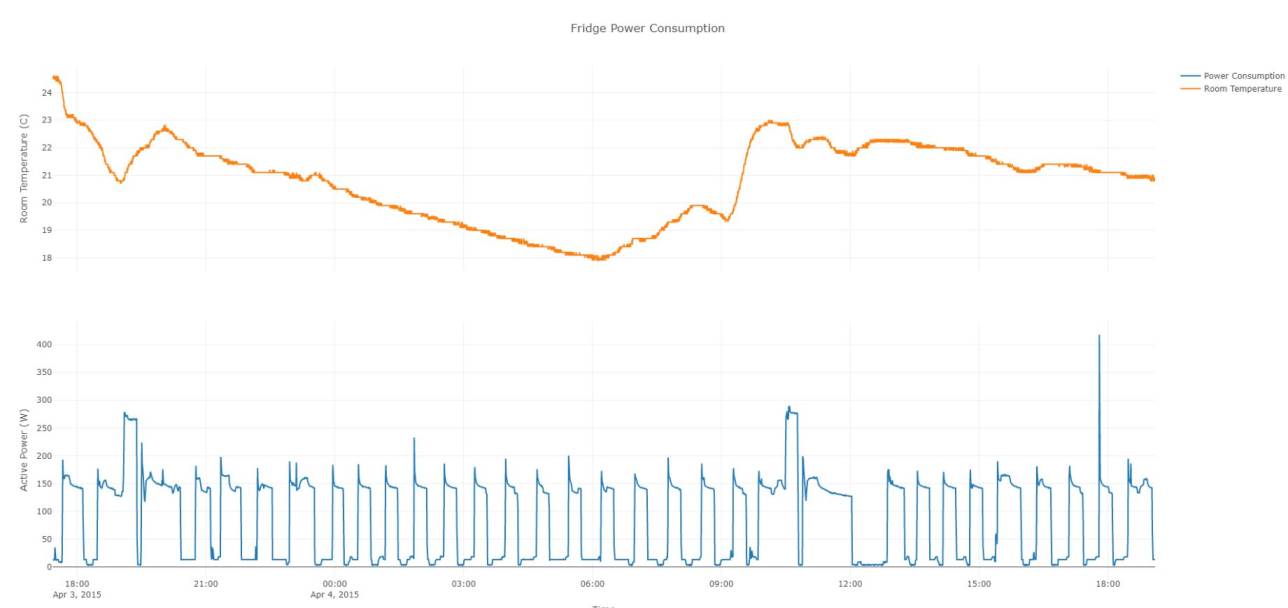 This Duty Cycle depends on a few factors, such as:
This Duty Cycle depends on a few factors, such as:
- Ambient temperatures: In the image above, you can see that whenever the room temperature increases the compressor has to work longer to maintain the set temperature inside the fridge. This results in power surges and longer duty cycles.
- Usage: When the refrigerator’s door is opened, the cool air escapes and is replaced by warmer air, which increases the overall temperature inside the fridge. Every time this happens, the compressor starts running again until the low-temperature setpoint is achieved.
- How full the refrigerator is: The emptier the refrigerator, the more air it has to cool down. This means that the emptier the fridge is, the longer the duty cycle is going to be.
There are more factors that come into play here, such as size, age, and the condition of the fridge. All of these factors make it very hard to track the exact run time and duty cycle of the refrigerator.
But, typically, most refrigerators have a duty cycle of about 33%, meaning that within a 24-hours pan, the compressor only really runs for 8 hours.
Therefore, if you know the wattage of your refrigerator, you could easily estimate how much energy it consumes using this simple formula:
Estimated Daily Energy Consumption (Wh) = Refrigerator Wattage (Watts) x 8 hours
Following our example of the LG refrigerator:
Estimated Daily Energy Consumption (Wh) = 305 Watts x 8 hours = 2440 Wh (Watt-hours)
If you suspect a longer duty cycle, you could use 10 or 12 hours instead of 8 hours.
Now that you know how to estimate your refrigerator’s daily energy consumption, you’ll need one more piece of information to accurately determine how much solar power you’ll need to run your fridge:
The amount of sunlight that the solar panels would receive. The sunlight that a solar panel receives is quantifiable and is referred to as Peak Sun Hours.
What are Peak Sun Hours?
In the solar industry, the standard unit for measuring Sunlight (i.e., Solar irradiance) is W/m2 (Watts per square meter).
Before a solar panel is given a Power rating (Wattage), it is tested under a set of conditions, referred to as the “Standard Test Conditions” (or STCs for short).
These STCs include a standard testing condition that simulates the amount of sunlight that a solar panel would receive under ideal conditions: 1000 W/m2 (1 kW/m2).
A Peak Sun Hour refers to the amount of energy received from the sun in one hour under these ideal conditions.
In other words, if an area receives exactly 1000 W/m2 (1 kW/m2) of sunlight for exactly 1 hour, by the end of that hour, the same area would have received exactly 1000 Wh/m2 (1 kWh/m2) of energy from the sun, and it could be said that the area received exactly 1 Peak Sun Hour.
If an area receives exactly 1000 W/m2 (1 kW/m2) of sunlight for exactly 3 hours, by the end of those 3 hours, the same area would have received exactly 3000 Wh/m2 (3 kWh/m2) of energy from the sun, could be said to have received exactly 3 Peak Sun Hours.
In practice, solar panel exposure to sunlight varies and doesn’t remain consistent for extended periods like 3 hours or even 1 hour.
However, by continuously monitoring it throughout the day, and despite the fluctuations in actual sunlight received by the solar panel, we can calculate the cumulative amount of sunlight energy known as Peak Sun Hours.
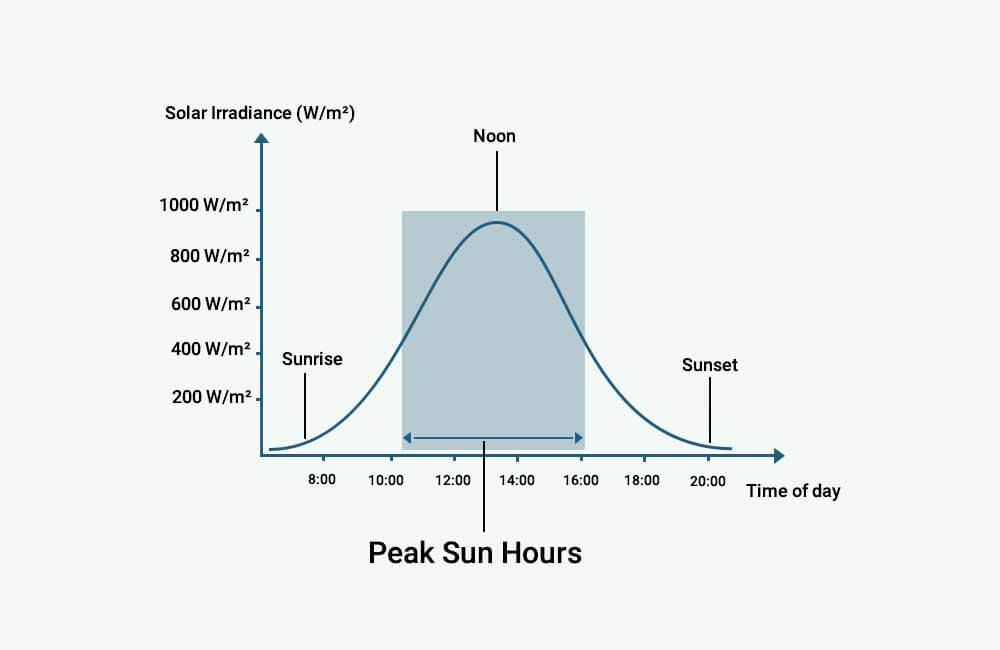
But, why are Peak Sun Hours important?
Well, Peak Sun Hours help us determine how much energy solar panels would be able to produce in a certain location:
Daily Energy Production (Watt-hours) = Solar Panel Wattage (Watts) x Daily Peak Sun Hours
Reversibly, and more importantly in our case, if you know how much energy you need the solar panels to produce on a daily basis, you can use the daily Peak Sun Hours in your location to determine the size of the solar panel that you need:
Solar Panel Wattage (Watts) = Required Daily Energy Production (Watt-hours) ÷ Daily Peak Sun Hours
For example:
- If we need to produce 500Wh (Watt-hours) of energy per day in an area that receives 5 Peak Sun Hours a day, We’ll need a solar panel that is rated at 100 Watts. (500Wh ÷ 5 Peak Sun Hours = 100W)
- If we need to produce 1500Wh (Watt-hours) of energy per day in an area that receives 3 Peak Sun Hours a day, We’ll need a solar array that is rated at 500 Watts. (1500Wh ÷ 3 Peak Sun Hours = 500W)
Since we’ve already covered the energy consumption of your refrigerator, all we need now is the Peak Sun Hours that you receive in your location.
How many Peak Sun Hours do you receive in your location?
There are many resources online that can help you find the daily Peak Sun Hours in your location. For example, here’s a map that illustrates the annual average daily peak sun hours in the U.S. (Click here for a higher resolution):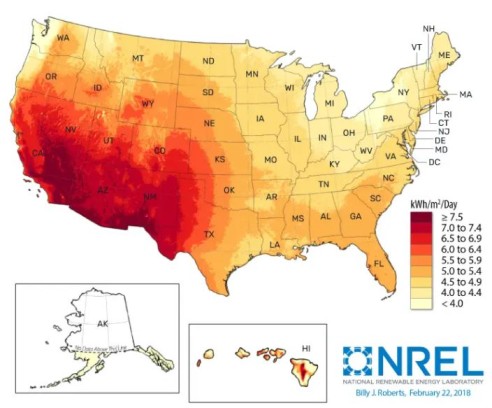
Source: National Renewable Energy Laboratory (NREL)
However, for more accurate information, I recommend using NREL’s PVWatts calculator.
All you have to do is submit the location in which the solar panels are going to be installed, go to the “Results” section of the tool, and it will give you the yearly and monthly average Peak Sun Hours estimates for that location:
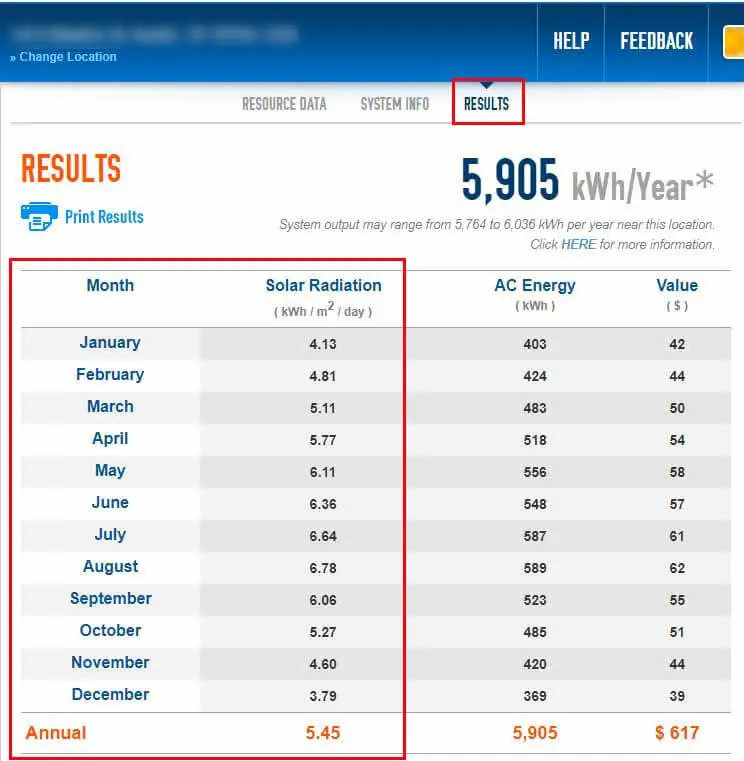
To keep your refrigerator running smoothly on solar power year-round, it’s wise to factor in the peak sun hours from December.
By doing so, you’ll ensure that your solar panels receive enough sunlight during the months when solar energy is relatively low. This way, your refrigerator will continue to operate without interruption throughout the entire year.
For example:
For this particular address that I submitted in the tool, a 100W solar panel would – on average – produce 545 Wh per day throughout the year. The same panel would only produce 379 Wh/day throughout the month of December.
Now let’s see how you can use this information to determine the amount of solar power that you need.
How much solar power do I need to run a refrigerator?
To determine how much solar power you need to run a refrigerator, divide the Daily energy consumption (Watt-hours) of your refrigerator by the number of Peak Sun Hours you get each day, and multiply everything by a factor of 1.15 to account for system losses.
Solar power needed (Watts) = (Estimated Daily Energy Consumption (Wh) ÷ Peak Sun Hours (hours)) x 1.15
For example, let us make the following assumptions:
- Your refrigerator consumes around 1500 Wh of energy on a daily basis
- You receive 5 Peak Sun Hours a day
The amount of solar power that you need to run this fridge is:
Solar power needed (Watts) = (Estimated Daily Energy Consumption (Wh) ÷ Peak Sun Hours (hours)) x 1.15
Solar power needed (Watts) = (1500 Wh ÷ 5 hours) x 1.15
Solar power needed (Watts) = (300 Watt) x 1.15
Solar power needed (Watts) = 345 Watts
This means that we’d need – at least – 345 Watts of solar power to run the refrigerator. A solar system with this power rating would consist of 4 – 100W solar panels, 2 – 200W solar panels, or even a single residential solar panel rated at 345 Watts or more.
Here are a few examples of different refrigerators, their daily energy consumption, their location, and how much solar power would be needed for each of them to run:
| Model | Size (Cu. ft.) | Estimated daily energy consumption (Watt-hours) | Location | Estimated peak sun hours per day | Estimated solar power needed (Watts) |
| Kenmore 99059
|
4.5 Cu. ft. | 650 Wh/day | Denver, CO | 6.5 | 115W |
| Austin, TX | 5 | 150W | |||
| San Fransisco, CA | 6.5 | 115W | |||
|
|
12 Cu. ft. | 854 Wh/day | New York, NY | 4.5 | 220W |
| San Jose, CA | 6.5 | 150W | |||
| Pheonix, AZ | 7 | 140W | |||
| Frigidaire FFHT1425VV | 13.9 Cu. ft. | 909 Wh/day | Los Angeles, CA | 6.5 | 140W |
| Houston, TX | 4.5 | 230W | |||
| Raleigh, NC | 5 | 210W | |||
| 20.6 Cu. ft. | 1790 Wh/day | Charlotte, NC | 5 | 410W | |
| Philadelphia, PA | 4 | 515W | |||
| Los Angeles, CA | 6.5 | 315W | |||
| 27.4 Cu. ft. | 1994 Wh/day | San Diego, CA | 6.5 | 350W | |
| Chicago, IL | 4 | 575W | |||
| Austin, TX | 5 | 460W |
Now that we know how much solar power you’d need to run your fridge, let’s discuss the other components that you’ll require.
What size battery to run a refrigerator on solar power?
To run a refrigerator on solar power you’re going to need a battery bank that stores every bit of energy generated by the solar panels during the day, and make it available to the fridge at all times.
The size of the battery bank that you need will mainly on these variables:
- The Daily Energy Consumption of The refrigerator.: The battery bank should be big enough to store and supply the refrigerator’s daily energy requirements. The greater the energy consumption of your refrigerator, the bigger the battery bank.
- The Depth Of Discharge (DOD) of the battery bank: The Depth Of Discharge (DOD) of a battery indicates the recommended percentage of its total capacity that should be utilized. For instance, if a battery has a rating of 1200 Watt-hours and a recommended DOD of 50%, it means that only 600 Watt-hours of the battery’s energy capacity can be effectively utilized. The remaining 50% is best preserved to maintain the battery’s performance and longevity. The greater the permissible depth of discharge for the battery bank, the smaller the required size of the battery bank can be.
- Days Of Autonomy: This is essentially an energy backup plan. Days Of Autonomy represent the number of days for which you suspect a low solar input and would have to rely solely on the battery bank to run the refrigerator.
Once these variables are determined, the Energy Capacity (in Watt-hours) of the battery bank that you need is calculated as such:
Energy Capacity (Wh) = (Daily Energy Consumption of the refrigerator (Wh) x Days Of Autonomy) ÷ (Depth Of Discharge (%) x 0.85)
Please note that the 0.85 factor in the formula is used to account for system losses (mainly inverter inefficiency).
To better explain this, consider the following example:
Let’s say I have a 14 Cu. Ft. refrigerator that uses around 1000 Wh (1 kWh) of energy on a daily basis, and I want the battery bank to be able to run the refrigerator for 3 days in case there’s not enough sunlight to rely on the solar panels.
So, the fridge’s daily energy consumption is 1000 Wh, and the Days Of Autonomy are 3. But, what about the Depth Of Discharge (DOD)?
Well, the DOD that we use in the formula will depend entirely on the type of batteries we’re going to use.
The most common types of batteries uses in these applications are Lead-Acid batteries and Lithium batteries.
Generally, Lead-Acid batteries have a recommended DOD of 50%, meaning that it is not recommended to discharge them below 50% of their rated capacity.
On the other hand, Lithium batteries have a recommended DOD of at least 80%, meaning that they can be repeatedly discharged to 20% of their rated capacity without sustaining any permanent damage.
Some Lithium battery suppliers will even guarantee a 10-year life span (3500+ daily charge/discharge cycles) at a 100% DOD.
To illustrate how much of a difference the recommended DOD of a battery makes, let’s continue our example, and calculate the required battery size for each case.
Lead-Acid Battery Bank:
If we use Lead-Acid batteries for our system, the size of the battery bank is calculated as such:
Energy Capacity (Wh) = (Daily Energy Consumption of the refrigerator (Wh) x Days Of Autonomy) ÷ (Depth Of Discharge (%) x 0.85)
Energy Capacity (Wh) = (1000 Wh x 3) ÷ (50% x 0.85)
Energy Capacity (Wh) = (3000 Wh) ÷ (0.5 x 0.85)
Energy Capacity (Wh) = (3000 Wh) ÷ (0.425)
Energy Capacity (Wh) = 7058 Watt-hours
If we use these WindyNation batteries, which are rated at 1200 Wh each (12V – 100 Ah), we would require 6 batteries:
The number of batteries = Energy Capacity of the battery bank (Wh) ÷ Energy Capacity of each battery (Wh)
The number of batteries = 7058 Wh ÷ 1200 Wh
The number of batteries = 5.88 batteries
Lithium Battery Bank:
Let’s say we choose to use these LiTime batteries, which are LiFePO4 (Lithium Iron Phosphate) which the supplier claims would last 4000 Charge/Discharge cycles even at a 100% DOD.
The size of the battery bank that consists of these batteries is calculated as such:
Energy Capacity (Wh) = (Daily Energy Consumption of the refrigerator (Wh) x Days Of Autonomy) ÷ (Depth Of Discharge (%) x 0.85)
Energy Capacity (Wh) = (1000 Wh x 3) ÷ (100% x 0.85)
Energy Capacity (Wh) = (3000 Wh) ÷ (1 x 0.85)
Energy Capacity (Wh) = (3000 Wh) ÷ (0.85)
Energy Capacity (Wh) = 3529 Watt-hours
These LiTime batteries are also rated at 1200 Wh each (12V – 100 Ah). So, we would require 3 batteries:
The number of batteries = Energy Capacity of the battery bank (Wh) ÷ Energy Capacity of each battery (Wh)
The number of batteries = 3529 Wh ÷ 1200 Wh
The number of batteries = 2.9 batteries
Click here to read more about batteries, their types, their electrical ratings, and how many of them you would need to run your refrigerator.
Now, that we know how many solar panels and batteries you’ll need to run your fridge, let’s talk about another component that you’ll need for your system: The solar charge controller.
In the next section, I explain what a solar charge controller is, why you’ll need one, and how you can size it properly.
What size solar charge controller do I need to run a refrigerator on solar power?
Solar charge controllers are electronic devices that connect the solar panels to the battery and are used in solar energy systems to maximize power production and protect the battery bank and the solar panels.
There are 2 types of solar charge controllers that you could use:
While PWM charge controllers are the cheaper option, MPPT charge controllers are a newer and more efficient technology. In fact, using an MPPT charge controller can boost your system’s efficiency by up to 25%.
That’s why in this section, I’ll be focusing on MPPT charge controllers, as they offer a significant advantage in terms of efficiency compared to PWM controllers.
However, if you’re convinced that a PWM charge controller is more suitable for your needs/budget, feel free to check out this PWM charge controller calculator that’ll help you choose the right PWM for your system.
Now, MPPT charge controllers have 3 ratings that you should pay attention to:
- Their Output Current Rating (in Amps): This rating indicates the maximum amount of Electrical Current (Amps) that the MPPT is capable of delivering at its output.
- Their Input Voltage Rating (in Volts): This rating indicates the maximum Voltage that the MPPT can handle at its input.
- Their Output Voltage Rating (in Volts): This rating represents the Voltage that the MPPT is designed to output.
I’ve written a comprehensive guide on how to choose the right MPPT charge controller for your system. In this guide, I use an example system to illustrate the necessary calculations for determining the appropriate ratings of the MPPT controller.
But to make things even easier for you, I’ve gone a step further and created an MPPT calculator. By simply describing your system, the calculator will do the work for you, suggesting the ideal MPPT controller that matches your specific needs.
For example, let’s say you’ve determined that you’ll need a 200W solar array, and 12V – 100 Ah battery to run your refrigerator.
Let’s also make the following assumptions:
- For your solar array, you chose to use 2 of these 100W-12V Monocrystalline Solar Panels from Renogy wired in series to make a 24V solar array.
- For your battery bank, you chose to use this 12V – 100Ah LiTime LiFePO4 battery.
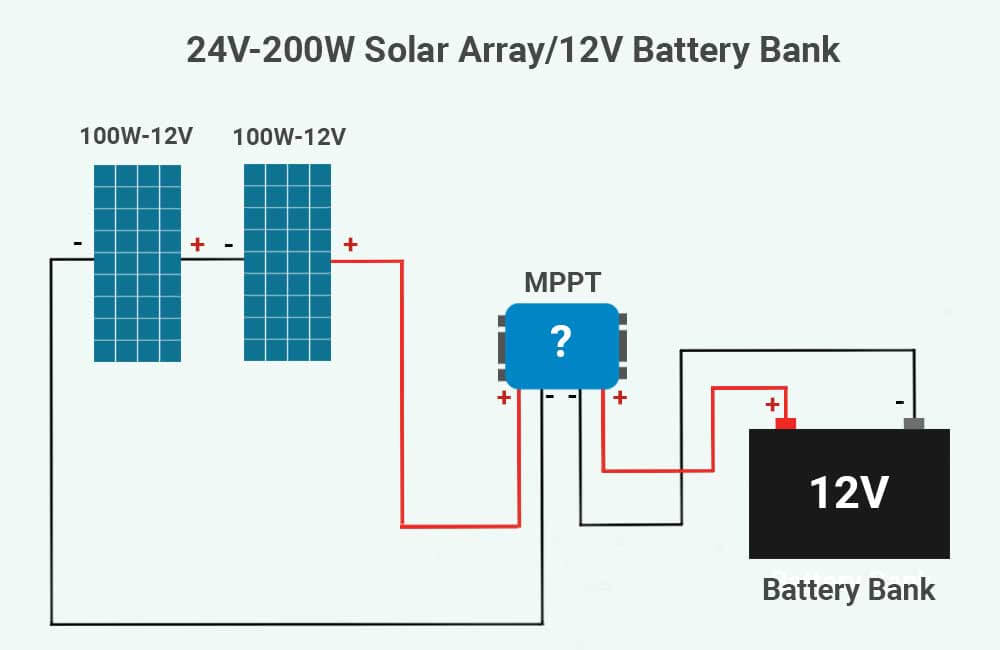
Now, if we go to our MPPT calculator (here), here are the inputs that describe our system:
1- Solar Panel Wattage: This is the watt rating on each of your solar panels. In our case, each solar panel is rated at 100 Watts.
2- Solar panel Open-Circuit voltage (Voc): You can find this value in the specification label on the back of your solar panels, or by looking up the specific model. In our example, the 100W Renogy solar panels each have an Open-Circuit Voltage rating of 22.3 Volts.
3- Battery bank voltage (Nominal Voltage): In our example, the battery bank is rated at 12V.
4- Lowest temperature during sunlight hours: In this field, you should enter the lowest temperature that you suspect your solar panels are ever going to be exposed to during daytime hours. For the sake of this example, we’ll assume the temperature does not go below 20°F during daytime hours.
5- Number of strings: The solar panels in our example are wired in series, so the number of strings is 1.
6- Number of solar panels in each string: We have 2 solar panels in series, so we’ll enter 2 in this input.
After submitting these details to the calculator, here are the results:
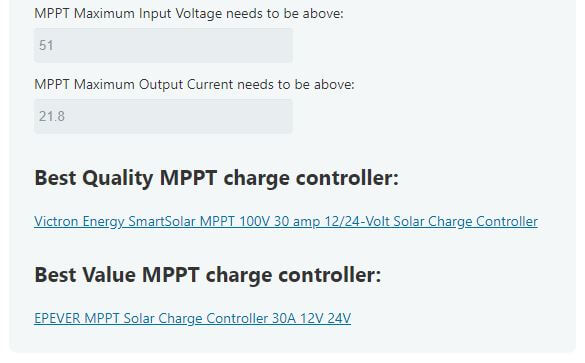
According to the calculator, the MPPT charge controller that we need for this system needs to have an Input Voltage rating of 51 Volts or more and an Output Current rating of 21.8 Amps or more.
The calculator took these ratings into account and provided a couple of direct links to MPPT charge controllers that match the system’s requirements.
Now that we know how much solar power, what size battery, and what size charge controller we need to run a refrigerator, one more essential component is left to discuss: The inverter.
What size inverter do I need for a refrigerator?
Solar panels generate DC (Direct Current) power, but most refrigerators require AC (Alternating Current) power to operate. To bridge this gap, an inverter is necessary to convert the low-voltage DC power from the batteries (ranging from 12-48V) into higher-voltage AC power (typically 110-130V) that the refrigerator can use.
Inverters are rated in Watts, indicating the amount of power they can continuously supply. For instance, a 500W inverter can consistently provide 500 Watts of power.
However. when selecting an inverter for your refrigerator, it’s important to ensure that it can handle both the running wattage (continuous power consumption) and the power surges required for starting up the fridge.

Power consumption of a 150W refrigerator.
Inverter manufacturers specify both the Continuous Power and the Surge Power capacities for their inverters. So, in order to find an inverter that matches your refrigerator’s requirements and could run it, you’ll have to figure out:
1- The refrigerator’s running wattage:
Which can be calculated by multiplying the rated Voltage (Volts) of the refrigerator by its rated Current (Amps) as specified on the fridge’s specification sheet:
Running Wattage = Rated Voltage x Rated Current
2- The refrigerator’s starting wattage:
Which is typically estimated since it’s not commonly provided by the manufacturer. On average, the starting wattage of a refrigerator ranges from 3 to 10 times its running wattage.
To err on the safe side, let’s assume a multiple of 10:
Starting Wattage = Rated Wattage x 10
However, it’s worth noting that a more accurate method for determining the starting wattage of your refrigerator is by referring to the Locked Rotor Amps (LRA) rating, typically indicated on the compressor.
This specification provides a more precise estimation of the potential watts that might be required during startup.
To calculate the starting wattage based on the LRA rating, you can use the following formula:
Potential Starting Wattage = Rated Voltage x Locked Rotor Amps
Click here to learn more about the starting wattage of your refrigerator.
For example, consider this LG refrigerator. 
The running wattage of this fridge can be calculated as such:
Running Wattage = Rated Voltage x Rated Current = 127 V x 2.4 A = 305 W
This means that the inverter that could run this refrigerator should have a Continuous Power rating of more than 305 Watts. But we still need to factor in the starting wattage of the refrigerator.
If the Locked Rotor Amps (LRA) rating of the refrigerator’s compressor is unknown, we can estimate the starting wattage using the assumed multiple of 10.
For example, if the running wattage of the refrigerator is 305W, the estimated starting wattage would be 305W x 10 = 3050W.
To find an appropriate inverter, we need one that can supply both the continuous running wattage (305W) and the estimated starting wattage (3050W).
While this 2000W Renogy inverter would meet these requirements, it might be overkill for most refrigerators since the starting wattage is more commonly around 5 times the running wattage. Therefore, rounding down the calculated starting wattage to 3000W would be more appropriate for this example.
In this case, the Aims 1500 Watts Inverter appears to be a suitable choice. It can provide 1500 Watts of continuous power and handle 3000 Watts of peak power, making it well-suited for running the refrigerator.
It’s also important to consider both the Waveform and Input Voltage compatibility of the inverter for optimal performance.
Firstly, it is recommended to choose a Pure Sine Wave inverter rather than a Modified Sine Wave Inverter. This ensures a cleaner and more stable power output, which is important for sensitive devices like refrigerators.
Secondly, the Input Voltage of the inverter should match the voltage of your battery bank. For instance, if your battery bank operates at 24 Volts, select an inverter explicitly rated for 24 Volts at its input.
For more detailed information on sizing an inverter for your refrigerator, I recommend reading the article I wrote specifically addressing this topic. It will provide you with valuable insights and guidance in selecting the right inverter for your specific needs.
Once you have correctly sized all the components for your system, it’s essential to also consider the sizing of wires and over-current protection devices such as fuses and circuit breakers that connect these components together.
To assist you further, here are some resources that provide information on wire sizing and fuse selection for specific connections within your system:
1- Solar panels to charge controller wire sizing: This resource will guide you in selecting the appropriate wire size for connecting your solar panels to the charge controller.
2- Solar charge controller to battery wire sizing: Here, you’ll find information on wire sizing for the connection between the solar charge controller and the battery bank.
3- Battery to inverter wire sizing: This resource will help you determine the suitable wire size for connecting the battery bank to the inverter.
4- What size fuse between solar panels and charge controller?: Here, you’ll find guidance on selecting the correct fuse size for protection between the solar panels and the charge controller.
5- What size fuse between charge controller and battery bank?: This resource provides information on determining the proper fuse size for protection between the charge controller and the battery bank.
6- What size fuse between battery bank and inverter?: Here, you’ll find details on choosing the right fuse size for protection between the battery bank and the inverter.






















Great content. Very useful in trying to decide an off grid small system for the cottage in Sri Lanka. I am planning this from London. Thank you very much.
Doesn’t appear to have the wattage used by the defrost cycle, my 17 cubic ft fridge has 220 watts on the defrost cycle, not sure that is included in the Rated Amps?
Great información. It cleared up alot of things. Great explanation!
A very well explained system , but do you really need a pure sine wave inverter to run a small fridge , i am very curious about this modified sine wave and the pure sine wave inverters ,i would really appreciate your suggestion , greetings and a great thank you for your good work .
One of the most comprehensive and logically laid out information articles I have read. It covers all the issues one needs to consider when planning a solar conversion.
By far the best article I’ve found on sizing a system! Thank you so much!
Clear, easily understandable explanations. Exactly what I needed to assess my setup: 2x300W solar panels in parallel runs a 1000W inverter+controller in circuit. I have 3x100Ah , 12V batteries. I need find out if this is optimum way to delivery enough power to heat and light up my chicken house. Thanks